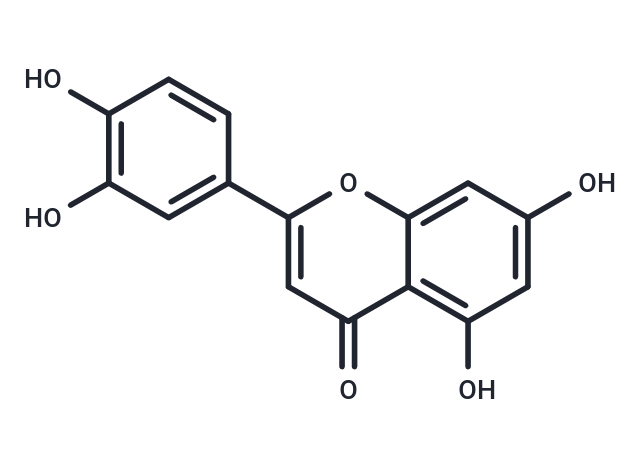Shopping Cart
Remove All Your shopping cart is currently empty
Your shopping cart is currently empty
Luteolin (Luteolol) belongs to the flavonoid group of natural products and is a Nrf2 inhibitor, PDE inhibitor. Luteolin has a wide range of biological activities including antitumor, antioxidant, anti-inflammatory, antimicrobial, antiviral, antiallergic, and procoagulant.

| Pack Size | Price | USA Warehouse | Global Warehouse | Quantity |
|---|---|---|---|---|
| 5 mg | $30 | In Stock | In Stock | |
| 10 mg | $37 | In Stock | In Stock | |
| 25 mg | $40 | In Stock | In Stock | |
| 50 mg | $43 | In Stock | In Stock | |
| 100 mg | $52 | In Stock | In Stock | |
| 500 mg | $141 | In Stock | In Stock | |
| 1 mL x 10 mM (in DMSO) | $41 | In Stock | In Stock |
| Description | Luteolin (Luteolol) belongs to the flavonoid group of natural products and is a Nrf2 inhibitor, PDE inhibitor. Luteolin has a wide range of biological activities including antitumor, antioxidant, anti-inflammatory, antimicrobial, antiviral, antiallergic, and procoagulant. |
| Targets&IC50 | PDE5:9.5 μM (Ki), PDE2:6.4 μM (Ki), PDE3:13.9 μM (Ki), PDE1:15.0 μM (Ki), PDE4:11.1 μM (Ki) |
| In vitro | METHODS: ESCC cell lines EC1, EC9706, KYSE30 and KYSE450 were treated with Luteolin (10-80 µM) for 48-72 h. Cell viability was measured using the CCK-8 Assay. RESULTS: Luteolin inhibited the growth of ESCC cell lines in a dose-dependent manner with IC50 in the range of 20-60 µM. [1] METHODS: Human cervical cancer cells, HeLa, were treated with Luteolin (5-20 µM) for 48 h. Cell cycle profiles were analyzed using Flow Cytometry. RESULTS: Luteolin treatment blocked the cell cycle progression of HeLa cells in sub-G1 phase. [2] |
| In vivo | METHODS: To detect anti-tumor activity in vivo, Luteolin (50 mg/kg) was injected intraperitoneally once daily for eighteen days into BALB/C-nu mice bearing ESCC tumor EC1. RESULTS: The Luteolin treatment group showed a reduction in tumor size and a reduction in total tumor weight of about 65%. [1] METHODS: To study the effect on intestinal mucositis, Luteolin (3-30 mg/kg in water plus 1% Tween) was administered by gavage or intraperitoneally to irinotecan-induced intestinal mucositis in Swiss mice once a day for fourteen days. RESULTS: Luteolin prevented irinotecan-induced intestinal damage by reducing weight loss and diarrhea scores as well as attenuating duodenal and colonic shortening. [3] |
| Synonyms | Luteolol, Luteoline, Flacitran, Digitoflavone |
| Molecular Weight | 286.24 |
| Formula | C15H10O6 |
| Cas No. | 491-70-3 |
| Smiles | O=C1C=2C(OC(=C1)C3=CC(O)=C(O)C=C3)=CC(O)=CC2O |
| Relative Density. | 1.2981 g/cm3 (Estimated) |
| Color | Yellow |
| Appearance | Solid |
| Storage | Powder: -20°C for 3 years | In solvent: -80°C for 1 year | Shipping with blue ice/Shipping at ambient temperature. | ||||||||||||||||||||||||||||||||||||||||
| Solubility Information | H2O: < 1 mg/mL (insoluble or slightly soluble) DMSO: 126.25 mg/mL (441.06 mM), Sonication is recommended. Ethanol: 3 mg/mL (10.48 mM), Heating is recommended. | ||||||||||||||||||||||||||||||||||||||||
| In Vivo Formulation | 10% DMSO+40% PEG300+5% Tween 80+45% Saline: 5.7 mg/mL (19.91 mM), Suspension. Please add the solvents sequentially, clarifying the solution as much as possible before adding the next one. Dissolve by heating and/or sonication if necessary. Working solution is recommended to be prepared and used immediately. The formulation provided above is for reference purposes only. In vivo formulations may vary and should be modified based on specific experimental conditions. | ||||||||||||||||||||||||||||||||||||||||
Solution Preparation Table | |||||||||||||||||||||||||||||||||||||||||
Ethanol/DMSO
DMSO
| |||||||||||||||||||||||||||||||||||||||||
| Size | Quantity | Unit Price | Amount | Operation |
|---|

Copyright © 2015-2025 TargetMol Chemicals Inc. All Rights Reserved.